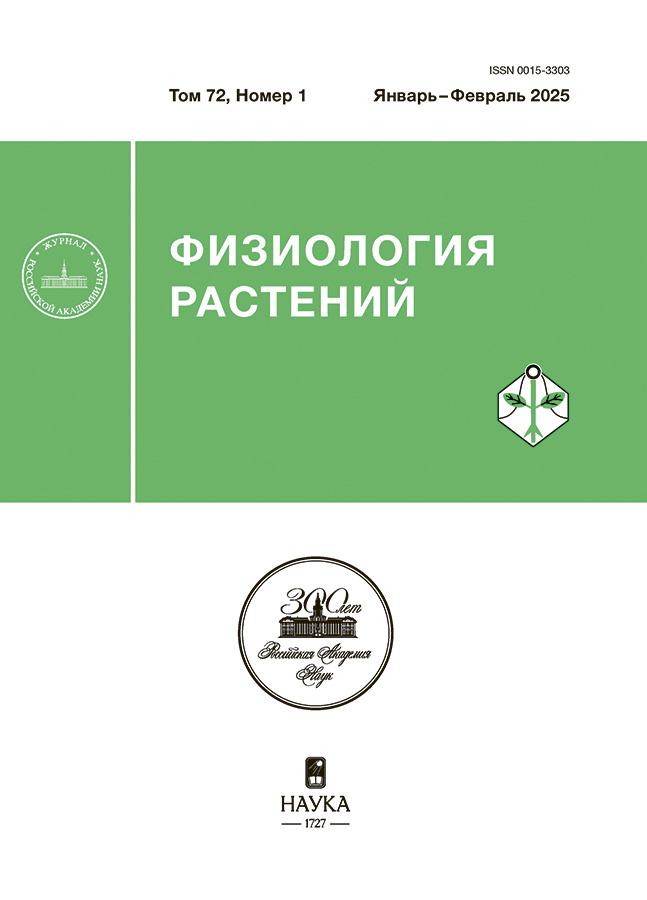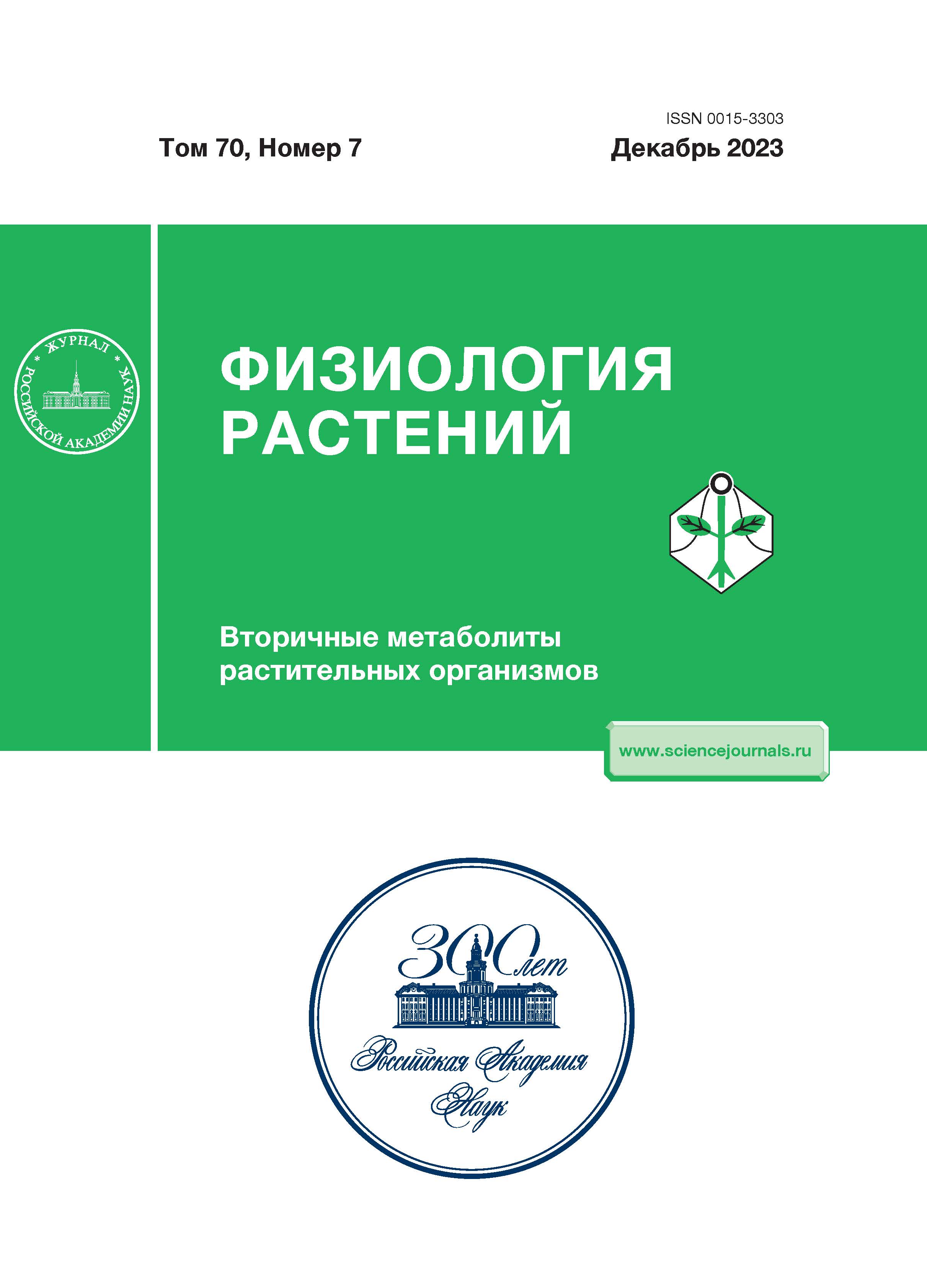Management of Biosynthetic Potential of Aseptic Plants and Callus Cultures of Ocimum basilicum L. In Vitro
- Authors: Cherednichenko M.Y.1, Polivanova O.B.1, Khlebnikova D.A.1, Slovareva O.Y.2, Kirakosyan R.N.1, Kalashnikova E.A.1
-
Affiliations:
- Russian State Agrarian University—Moscow Timiryazev Agricultural Academy
- All-Russia Center for Plant Quarantine
- Issue: Vol 70, No 7 (2023)
- Pages: 846-857
- Section: ЭКСПЕРИМЕНТАЛЬНЫЕ СТАТЬИ
- URL: https://cardiosomatics.ru/0015-3303/article/view/648236
- DOI: https://doi.org/10.31857/S0015330323600778
- EDN: https://elibrary.ru/ZQSCWE
- ID: 648236
Cite item
Abstract
Callus cultures and microclones of sweet basil (Ocimum basilicum L.) were obtained in vitro and their growth and biochemical characteristics were studied depending on the hormonal composition of the MS medium as well as on the addition of zinc ferrate nanoparticles (NPs) to the nutrient medium. During clonal micropropagation of samples, the advantage of various options for the composition of nutrient media was noted: adding NAA to the MS medium for the cultivars Lyubimchik and Vasilisk, IBA for the cultivar Fioletovy barkhat and the species sample from Germany, and IAA for species samples from Poland and Italy. It should be noted that plants of the purple-leaved cultivar Fioletovy barkhat preferred MS medium containing mineral salts at a concentration of ½ normal. The results of the study confirmed the hypothesis put forward by various authors about the ability of microplants and basil callus cells to accumulate secondary metabolites as well as the possibility of controlling this process with the help of biological (mineral and hormonal composition of the nutrient medium) and physical (NP) elicitors. It was shown that the presence of zinc ferrate NPs in the MS medium contributed to the formation of callus tissue of different types of density and color. The addition of 25 μg/L NPs to the MS medium significantly increased the fresh biomass of callus tissue compared to other experimental options. In this variant, the growth index of callus tissue was the highest and amounted to 3.55. When the concentration of NPs increased to 50 μg/L, a decrease in the growth index was noted, which indicates their inhibitory effect on the proliferative activity of dedifferentiated cells. A comprehensive analysis of phenolic compounds was carried out in the resulting cell cultures. It was revealed that the accumulation of the total phenolics and flavonoids does not depend on the concentration of NPs in the MS medium.
About the authors
M. Yu. Cherednichenko
Russian State Agrarian University—Moscow Timiryazev Agricultural Academy
Email: cherednichenko@rgau-msha.ru
Moscow, Russia
O. B. Polivanova
Russian State Agrarian University—Moscow Timiryazev Agricultural Academy
Email: cherednichenko@rgau-msha.ru
Moscow, Russia
D. A. Khlebnikova
Russian State Agrarian University—Moscow Timiryazev Agricultural Academy
Email: cherednichenko@rgau-msha.ru
Moscow, Russia
O. Yu. Slovareva
All-Russia Center for Plant Quarantine
Email: cherednichenko@rgau-msha.ru
r.p. Bykovo, Moscow oblast, g.o. Ramensky, Russia
R. N. Kirakosyan
Russian State Agrarian University—Moscow Timiryazev Agricultural Academy
Email: cherednichenko@rgau-msha.ru
Moscow, Russia
E. A. Kalashnikova
Russian State Agrarian University—Moscow Timiryazev Agricultural Academy
Author for correspondence.
Email: cherednichenko@rgau-msha.ru
Moscow, Russia
References
- World Flora Online (WFO). http://www.worldfloraonline.org (дата обращения 29.08.2023).
- Севрук И.А., Писарев Д.И., Новиков О.О., Алексеева К.А., Малютина А.Ю. Исследование состава эфирного масла базилика обыкновенного ‒ Ocimum basilicum L. флоры Белгородской области // Научные результаты биомедицинских исследований. 2015. Т. 1. № 3. С. 97. https://doi.org/10.18413/2313-8955-2015-1-3-97-103
- Писарев Д.И., Алексеева К.А., Новиков О.О., Корниенко И.В., Севрук И.А. Химическое изучение состава антоцианов травы Ocimum basilicum L. // Научные результаты биомедицинских исследований. 2015. Т. 1. № 4. С. 119. https://doi.org/10.18413/2313-8955-2015-1-4-119-124
- Murashige T., Skoog F. A revised medium for rapid growth and bioassays with tabacco tissue cultures // Physiol. Plant. 1962. V. 15. P. 473. https://doi.org/10.1111/j.1399-3054.1962.tb08052.x
- Aiyegoro O.A., Okoh A.I. Preliminary phytochemical screening and in vitro antioxidant activities of the aqueous extract of Helichrysum longifolium DC // BMC Complemen. Altern. Med. 2010. V. 10. P. 1. https://doi.org/10.1186/1472-6882-10-21
- Baghel P.S., Ray S. Preliminary phytochemical screening of certain aphrodisiac plants used in traditional system of medicine // Int. J. Botany Stud. 2017. V. 2. P. 33.
- Sreevidya N., Mehrotra S. Spectrophotometric method for estimation of alkaloids precipitable with Dragendorff’s reagent in plant materials // J. AOAC Int. 2003. V. 86. P. 1124. https://doi.org/10.1093/jaoac/86.6.1124
- Obianime A.W., Uche F.I. The phytochemical screening and effects of methanolic extract of Phyllanthus amarus leaf on the biochemical parameters of male guinea pigs // J. Appl. Sci. Environ. Manage. 2008. V. 12. P. 73. https://doi.org/10.4314/jasem.v11i4.55199
- Ruthiran P., Selvaraj C.I. Phytochemical screening and in vitro antioxidant activity of Parkia timoriana (DC.) Merr. // Res. J. Biotech. 2017. V. 12. P. 47.
- Singleton V.L., Rossi J.A. Colorimetry of total phenolics with phosphomolybdic-phosphotungstic acid reagents // Am. J. Enol. Vitic. 1965. V. 16. P. 144. https://doi.org/10.5344/ajev.1965.16.3.144
- Запрометов М.Н. Фенольные соединения и методы их исследования // Биохимические методы в физиологии растений / Под ред. О.А. Павлиновой. М.: Наука, 1971. С. 185.
- Chang C., Yang M., Chern J. Estimation of total flavonoid content in propolis by two complementary colorimetric methods // J. Food Drug Anal. 2002. V. 10. P. 178. https://doi.org/10.38212/2224-6614.2748
- Stanojević L., Stanković M., Nikolić V., Nikolić L., Ristić D., Čanadanovic-Brunet J., Tumbas V. Antioxidant activity and total phenolic and flavonoid contents of Hieracium pilosella L. extracts // Sensors. 2009. V. 9. P. 5702. https://doi.org/10.3390/s90705702
- Бутенко Р.Г. Культура изолированных тканей и физиология морфогенеза растений. М.: Наука, 1964. 350 с.
- Бутенко Р.Г. Клеточные и молекулярные аспекты морфогенеза растений in vitro // I Чайлахяновские чтения. Пущино: Пущинский НЦ, 1994. С. 7.
- Бутенко Р.Г. Биология клеток высших растений in vitro и биотехнологии на их основе. М.: ФБК-ПРЕСС, 1999. 160 с.
- Носов А.М. Функции вторичных метаболитов растений in vivo и in vitro // Физиология растений. 1994. Т. 41. С. 873.
- Носов А.М. Культура клеток высших растений ‒ уникальная система, модель, инструмент // Физиология растений. 1999. Т. 46. С. 837.
- Nosov A.M. Application of cell technologies for production of plant-derived bioactive substances of plant origin // Appl. Biochem. Microbiol. 2012. V. 48. P. 609. https://doi.org/10.1134/S000368381107009X
- Kumar D.R., Kumar S.A. Plant biotechnology: importance of plant tissue culture, applications and advantages // Eur. Academic Res. 2015. V. III. Iss. 6. P. 6134.
- Siddique I., Anis M. An improved plant regeneration system and ex vitro acclimatization of Ocimum basilicum L. // Acta Physiol. Plant. 2008. V. 30. P. 493. https://doi.org/10.1007/s11738-008-0146-6
- Shahzad A., Faisal M., Ahmad N., Anis M., Alatar A., Hend A.A. An efficient system for in vitro multiplication of Ocimum basilicum through node culture // Afr. J. Biotechnol. 2012. V. 11. P. 6055. https://doi.org/10.5897/AJB12.154
- Verma S.K., Sahin G., Das A.K., Gurel E. In vitro plant regeneration of Ocimum basilicum L. is accelerated by zinc sulfate // In Vitro Cell. Dev. Biol. Plant. 2016. V. 52. P. 20. https://doi.org/10.1007/s11627-015-9739-0
- Dode L.B., Bobrowski V.L., Bolacel Braga E.J., Kömmling Seixas F., Wulff Schuch M. In vitro propagation of Ocimum basilicum L. (Lamiaceae) // Acta Sci. Biol. Sci. 2003. V. 25. P. 435.
- Begum F., Amin M.N., Azad M.A.K. In vitro rapid clonal propagation of Ocimum basilicum L. // Plant Tissue Cult. Biotechnol. 2002. V. 12. P. 27.
- González-Sánchez M.I., Lee P.T., Guy R.H., Compton R.G. In situ detection of salicylate in Ocimum basilicum plant leaves via reverse iontophoresis // Chem. Commun. 2015. V. 51. P. 16534. https://doi.org/10.1039/C5CC06909B
- Тужикова М.О. Оценка роста каллусной культуры базилика обыкновенного // Актуальные проблемы биомедицины – 2021: Материалы XXVII Всероссийской конференции молодых ученых с международным участием. Санкт-Петербург, 2021. С. 287.
- Bhuvaneshwari K., Sathya B., Gokulanathan A., Jayanthi M., Girija S. Induction of in vitro roots from leaf callus of Ocimum basilicum L. and O. tenuiflorum L. // Plant Cell Biotechnol. Mol. Biol. 2012. V. 13. P. 15. https://doi.org/10.1016/j.foodchem.2015.07.136
- Jiang X., Liu Y., Li W., Zhao L., Meng F., Wang Y., Tan H., Yang H., Wei C., Wan X., Gao L. Tissue-specific, development-dependent phenolic compounds accumulation profile and gene expression pattern in tea plant [Camellia sinensis] // PLoS ONE. 2013. V. 8: e62315. https://doi.org/10.1371/journal.pone.0062315
- Bhuvaneshwari K., Gokulanathan A., Jayanthi M., Govindasamy V., Milella L., Lee S., Yang D.C., Girija S. Can Ocimum basilicum L. and Ocimum tenuiflorum L. in vitro culture be a potential source of secondary metabolites? // Food Chem. 2016. V. 194. P. 55. https://doi.org/10.1016/j.foodchem.2015.07.136
- Nazir M., Tungmunnithum D., Bose S., Drouet S., Garros L., Giglioli-Guivarc’h N., Abbasi B.H., Hano C. Differential production of phenylpropanoid metabolites in callus cultures of Ocimum basilicum L. with distinct in vitro antioxidant activities and in vivo protective effects against UV stress // J. Agric Food Chem. 2019. V. 67. P. 1847. https://doi.org/10.1021/acs.jafc.8b05647
- Sanni S., Onyeyili P.A., Sanni F.S. Phytochemical analysis, elemental determination and some in vitro antibacterial activity of Ocimum basilicum L. leaf extracts // Res. J. Phytochem. 2008. V. 2. P. 77.
- Khair-ul-Bariyah S., Ahmed D., Ikram M. Ocimum basilicum: a review on phytochemical and pharmacological studies // Pak. J. Chem. 2012. V. 2. P. 78. https://doi.org/10.15228/2012.v02.i02.p05
- El-Beshbishy H.A., Bahashwan S.A. Hypoglycemic effect of basil (Ocimum basilicum) aqueous extract is mediated through inhibition of α-glucosidase and α-amylase activities: an in vitro study // Toxicol. Ind. Health. 2012. V. 28. P. 42. https://doi.org/10.1177/0748233711403193
- Akoto C.O., Acheampong A., Boakye Y.D., Naazo A.A., Adomah D.H. Anti-inflammatory, antioxidant, and anthelmintic activities of Ocimum basilicum (Sweet Basil) fruits // J. Chem. 2020. V. 2020: 2153534. https://doi.org/10.1155/2020/2153534
- Marwat S.K., Khan M.S., Ghulam S., Anwar N., Mustafa G., Usman K. Phytochemical constituents and pharmacological activities of sweet Basil-Ocimum basilicum L. (Lamiaceae) // Asian J. Chem. 2011. V. 23. P. 3773.
- Rubab S., Hussain I., Khan B.A., Unar A.A., Abbas K.A., Khichi Z.H., Khan M., Khanum S., Rehman K.U., Khan H. Biomedical description of Ocimum basilicum L. // J. Islamic Int. Med. Coll. 2017. V. 12. P. 59.
- Shahrajabian M.H., Sun W., Cheng Q. Chemical components and pharmacological benefits of Basil (Ocimum basilicum): a review // Int. J. Food Prop. 2020. V. 23. P. 1961. https://doi.org/10.1080/10942912.2020.1828456
- Lang E., Amelunxen F., Friedrich H., Horster H. Morphometrische Untersuchungen zur Bildung und Akkumulation von Laminaceengerbstoffen in Ocimum basilicum Zellkulturen // Planta-Med. 1978. V. 33. P. 281.
- Ambreen M., Mirza S.A. Evaluation of anti-inflammatory and wound healing potential of tannins isolated from leaf callus cultures of Achyranthes aspera and Ocimum basilicum // Pak. J. Pharm. Sci. 2020. V. 33. P. 361. https://doi.org/10.1080/15226514.2018.1524828
Supplementary files












